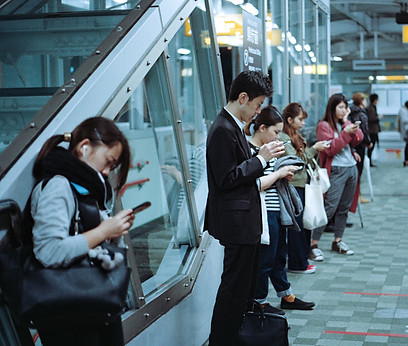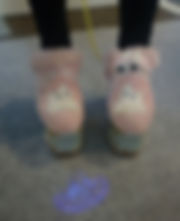
WEARABLE AURA
Personal projection to bring people closer
SUMMARY
Wearable Aura is a wearable device that promotes interaction between strangers in real-world situations.
The goal of this research is to explore a new way to connect people, offering an unexpected and playful experience.
This project is my Master Degree thesis. I led a team of 5 during the project development and towards the academic papers, winning the 2018 CHI Design Competiton.
SCOPE
Developing a tool to foster communication between strangers in real-life scenarios, and test it.
DELIVERABLES
-
Working prototype
-
Academic Papers and Posters
-
Concept video

PROBLEM
In Japan, face conversations, especially with strangers, preferring to hide behind a screen and look for interactions online.
Are we forgetting that the world around us is full of individuals to communicate with?
DESIGN PROCESS
Following the user-centered approach, I started with exploratory research to discover user needs and behaviors, followed by an iterative design process.

RESEARCH
We applied different research methods to better understand the problem and to define the basis for a solution. We run non-participant observations, literature reviews, competitive analysis, interviews, and focus groups. As a result, we stated the design key requirements.


2
Observations Sessions
20+
Literature Review

9
Interviews

3
Competitive Analysis
RESEARCH QUESTIONS
-
What are the obstacles to starting an interaction with a stranger?
-
What push people to start a conversation?
-
What existing tools foster interpersonal communication?
-
What makes an encounter comfortable for both parties?
1. NON-PARTICIPANT OBSERVATIONS
In order to understand the mental models of our end users, we examined the moment in which people initiate any interpersonal interaction. We observed people on the university campus and in the city (Tokyo).
Key insights
-
The distance between people plays a crucial role in the sparkle of an interaction
-
An unexpected event is a great excuse to start a conversation
-
People tend to look on the floor or on their phone when are alone, to avoid eye contact
-
Verbal and non-verbal cultural differences reduce the chance of an interaction
2. LITERATURE REVIEW
To have a better understanding of how interpersonal interactions start, and to seek design opportunities, we collected a bibliography of 20+ pieces, including articles, books, and similar studies. The following were the key topics from our exploration:
-
Proxemics and non-verbal communication
-
Pets as a social bridge in public spaces
-
Ice-breakers
-
Interactive design
Key insights
-
Non-verbal cues are crucial for the onset of human-to-human communication
-
Proxemics: social distance affects physical distance
-
How and why companion animals facilitate interpersonal connections
-
How initial shyness is overcome by social bonding activities
3. INTERVIEWS
We accessed to our end users directly interviewing our peers. Many students complain about the lack of communication inside the campus and the difficulties of making new friends.
We had an interview with 9 students from different countries and backgrounds.
During the interviews, we asked open-ended ones about their experiences, their social network and their personality.
Key insights
-
They are afraid of not be able to communicate to the other person due to language issues
-
They don't know the personal limits due to cultural differences
-
Most of them are clueless about what to start talking about
-
There is a stress factor because of shyness
-
They would like to talk to more people. They feel not-belonging in the community


4. COMPETITIVE ANALYSIS
We looked at the existing products with the objective of foster communication.
Most of them are online apps, with a first interaction happening online.
Our goal is to design a tool that helps the user to start a spontaneous and off-line communication.

KEY REQUIREMENTS

IDEATION
1. PERSONAE
In order to drive design decisions, I developed the two personae representative of the mindsets of our user groups, based on the learnings from the previous research.


2. CONCEPT GENERATION
We started sketching our ideas to visualize them, keeping in mind the three design requirements.
To validate the concept we run a focus group and 4 informal interviews.
2. STORYBOARDING
In order to understand deeper the device requirements, I draw use cases and user journeys, starting with a storyboard.
The goal was to capture the trigger event that starts the process, and then describe each step of the process including inputs, outputs, errors, and exceptions.


WEARABLE AURA
Wearable Aura is a wearable device that generates a customized and Interactive projection placed in Personal Distance Zone to encourage interpersonal interactions.
EVALUATION
ITERATION 1: LOW RES PROTOTYPE
We built a first prototype with low fidelity techniques to investigate whether Wearable Aura increments the interaction between strangers, and to estimate the visual impact of it in public contexts.
We tested it in a few public areas in Tokyo, with the of Wizard of Oz approach, as a non-participant observation and qualitative research.

RESULTS AND LEARNINGS
The on-field observations and the comparison between the results we obtained in different areas of the city, highlighted three main points for improvement:
-
User scenarios: the interaction happens if people are steady rather than walking
-
Area: the communication happens when people face each other
-
Interactivity: the interaction is not long enough to foster a conversation

ITERATION 2: HI-FI PROTOTYPE
With the feedback from our first testing, I designed and tested a second working prototype. Was improved:
-
Interaction: device responsive to users and environment
-
Personalization: the user can choose the preferred avatar
-
Environment: it was tested at Keio University public event



RESULTS AND LEARNINGS
The device was tested at a public event in Tokyo. One facilitator at a time was asked to walk around according to her preferences. Firstly we observed the reactions and whether it leads to an interplay. Then, we asked for their feedback in an informal interview.
The second prototype testing unveiled some issues to be fixed, and some good selling points to be developed further. Here the main findings:
-
Safety: avoid unwanted people to approach the user
-
Personalization: customize the animation is a key point for success.
-
Gestures: the movements observed were analyzed and used to improve the interactivity.
-
Single device: all the technology needs to be embedded in a single device to ensure to the user enough flexibility and movements freedom



"I enjoy Aura because it gives a reason to interact with people around you;
I felt the surrounding at my own pace".
User (Indonesia)
"Wearing Aura is fun. People would stop by and have conversations, and play with me. It reminds me of childhood and I prefer playing with strangers, instead of talking about the weather. "
User (China)


ITERATION 3: HI-FI PROTOTYPE
Following the learnings from previous prototypes, we finalized the design. Here the main characteristics of Wearable Aura after additional two user tests in the city:
-
Responsive to distance
-
Interactive
-
Personalised
-
Single device
-
Easy to switch on/off
FINALISED INTERACTION
Following the insights from the user tests, we improved the interaction.
We divided up the sequence into three consequent phases, each one happening at a certain distance range.
According to the phase, the animation changes shape and movements by a combination of autonomous and data controlled behavior.


FINAL DESIGN
CONCEPT VIDEO
We shot a video to show the concept and the functioning of the device.
It was part of the submission winning Student Design Competition at CHI.
PUBLICATIONS
-
Winner of ACM CHI 2018 Student Design Competition
-
Presented at ACM CHI 2018
-
Presented at ACM UbiComp 2017

